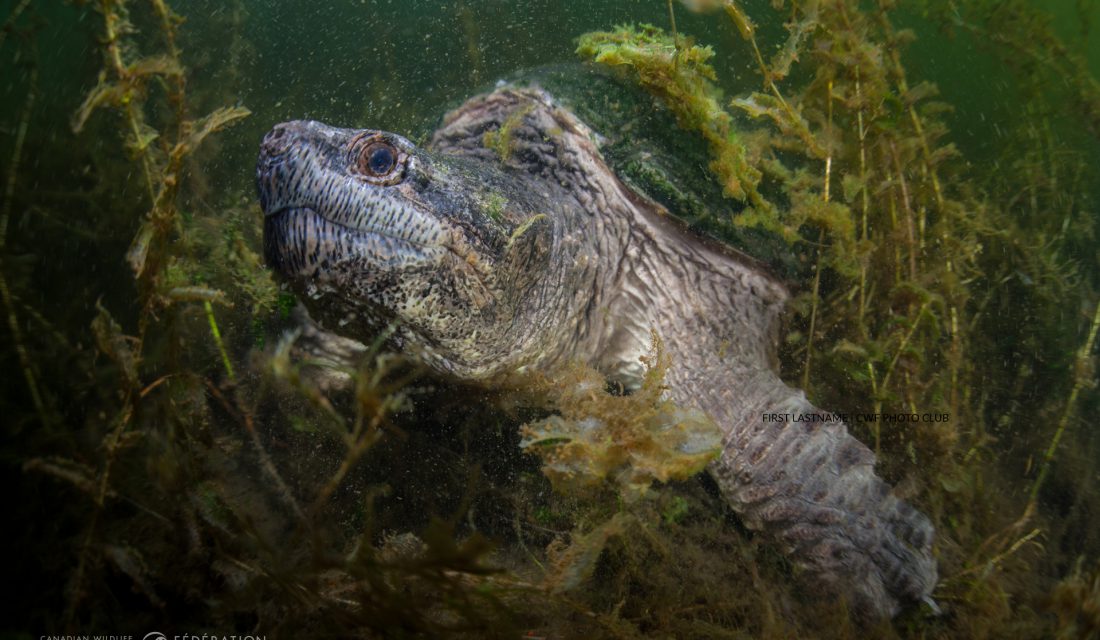We’ve all heard the stories.
(Cue spooky voice) “Snapping Turtles can grow to massive sizes, with jaws strong enough to bite through a broom handle — or worse — your toes!” Or, the version I was told, “There are ‘Snappers’ the size of bathtubs in Grenadier Pond; they’ll take your leg if you hang it over the side of the boat!”
With stories like these, it’s not surprising that many people have concerns over Snapping Turtles (often called Snappers) taking up residence in the water on their property. But how much truth is there to these stories?
Before going into the facts, I should stress that this blog post is about the Common Snapping Turtle (Chelydra serpentina), which is the only Snapping Turtle native to Canada, not the larger Alligator Snapping Turtle found in the US. Our Snapping Turtles can typically grow to about 30 centimetres in shell length and weigh 16 kilograms at most.
Fact or Myth?
 Now, let’s address the big question everyone always asks:
Now, let’s address the big question everyone always asks:
“Will a Snapper bite off my fingers?”
The short answer is no. There do not seem to be any verifiable instances of Common Snapping Turtles being able to perform this feat, or even a broom handle. One of the often-suggested methods of moving a Snapper off a road it to drag it by a stick it has bitten onto. Research in this area is sparse, but indicates that most humans can bite with more force than a Snapping Turtle.
 Snappers are quite docile in the water and their normal reaction to humans is to swim away. You may find the odd curious individual that approaches you to investigate, but they are smart enough to not provoke a larger creature for no reason. Most cases of Snapper bites seem to occur when people dangle their feet off a dock, probably because the Snapper can’t see most of you. Even in these situations, they are quick to realize their mistake and move on.
Snappers are quite docile in the water and their normal reaction to humans is to swim away. You may find the odd curious individual that approaches you to investigate, but they are smart enough to not provoke a larger creature for no reason. Most cases of Snapper bites seem to occur when people dangle their feet off a dock, probably because the Snapper can’t see most of you. Even in these situations, they are quick to realize their mistake and move on.
Most of the myths of this species being “aggressive” are a result of people provoking them on land. Unlike most turtles, Snapping Turtles are unable to fully pull into their shell for protection. As such, on land where they can’t escape quickly, they follow the saying of “The best defence is a good offence.” In the event a bite does occur, it will hurt and may warrant medical attention. But if you are a healthy adult any permanent damage beyond a scar is very rare.
“HELP! A Snapper Lurks on My Property!”
 So what you do if you find a Snapping Turtle living on your property? Our suggestion is to just leave it be. A Snapping Turtle greatly benefits the water body they are in by consuming dead matter and spreading the seeds of plants. This helps with nutrient cycling, and reduces bacteria counts in the water, giving you a cleaner, and healthier water body.
So what you do if you find a Snapping Turtle living on your property? Our suggestion is to just leave it be. A Snapping Turtle greatly benefits the water body they are in by consuming dead matter and spreading the seeds of plants. This helps with nutrient cycling, and reduces bacteria counts in the water, giving you a cleaner, and healthier water body.
Some precautions you may want to take if you do have a Snapping turtle living on your property include:
- Don’t feed them! This includes dumping scraps such as fish guts into the water. If your local Snappers expect to be fed on your property, they will visit more often.
- Wear foot coverings in the water. This gives some protection from a bite.
- Don’t leave kids and pets unattended in June when Snappers are more likely to be out of the water to nest.
- Give them space. Snappers rarely bite unless provoked.
- Check out our YouTube video on how to safely handle a Snapping Turtle
If you still have concerns over a Snapping Turtle on your property, consider the following: turtles generally establish their home ranges when they’re young and use different portions of it seasonally. Therefore, if you find an adult Snapper in your water one day, odds are that it has been visiting, or at least occasionally wandering through your property for many years, possibly even decades without you ever noticing it. It will likely leave just as quickly as it appeared.





4 comments
I read the article about mosquito zapper and have never thought they were good. My concern now is the neighborhood trend of spraying for mosquito called mosquito buzz. I think it is very harmful to all insects and can’t believe it is aloud in thus Country. Am I wrong?
I once prodded a medium /large turtle while scuba diving with a broom stick. It did snap it right off. However after swimming in my 100! acre pond for 40 years, I’ve never heard of anyone being bitten. And we’ve got some doozies!
This was a fascinating read! I had no idea snapping turtles could be so territorial. It definitely changes how I think about swimming in areas where they’re present. Thanks for the tips on staying safe!
This was an eye-opening post! I hadn’t realized how cautious one should be around snapping turtles. The blend of wildlife education and safety tips is so important for anyone who enjoys swimming in natural waters. Thanks for shedding light on this!